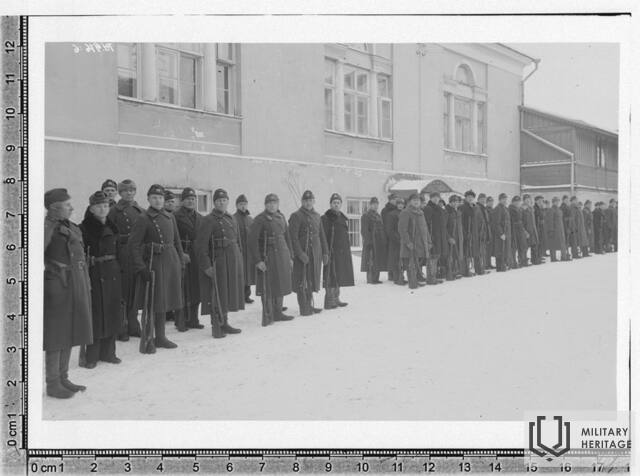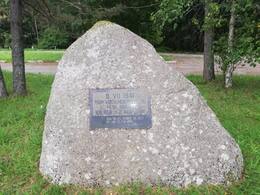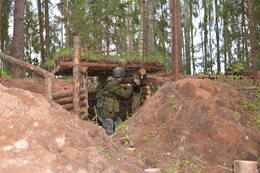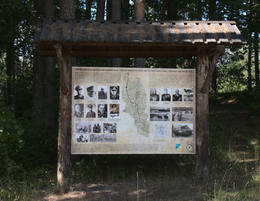Selbstverteidigung II Zweiter Weltkrieg
Omakaitse (Home Guard, Selbstschutz auf Deutsch) war eine Organisation der inneren Sicherheit in Estland während der deutschen Besatzung von 1941 bis 1944.
Bis Juni 1941 war ein Jahr vergangen, seit Estland von der Sowjetunion gewaltsam besetzt worden war, was eine Welle von Verhaftungen, Deportationen und Sowjetisierungen nach sich zog. Als sie in den ersten Wochen des Einmarsches in die Sowjetunion die schnell herannahenden deutschen Streitkräfte sahen, versteckten sich Tausende von Esten als sogenannte Waldbrüder in den Wäldern, um einer Einberufung durch die Rote Armee zu entgehen und die sowjetischen Behörden zu untergraben. Während des vorübergehenden Machtvakuums nach dem Rückzug der Bolschewisten und vor der Ankunft der deutschen Streitkräfte wurden viele estnische Regierungsbehörden wiederhergestellt, wobei die Grundlagen für die Einrichtung einer Strafverfolgungsstruktur gelegt wurden, die später Omakaitse genannt wurde. Die hauptsächlich aus ehemaligen Mitgliedern des Verteidigungsbundes bestehende Organisation der inneren Sicherheit hatte die Aufgabe, Vernichtungsbataillone und Reste der Roten Armee zu bekämpfen und das Gesetz durchzusetzen. Personen, die der Kollaboration mit sowjetischen Behörden verdächtigt wurden, wurden festgenommen und einige sogar nach dem Pöbelgesetz getötet. Deutsche Behörden benutzten Mitglieder der Omakaitse, um ihre antisemitische Vernichtungspolitik durchzusetzen.
Nachdem die deutschen Streitkräfte Estland besetzt hatten, lösten die deutschen Militärbehörden Omakaitse auf und ließen die Waldbrüder, die am Sommerkrieg 1941 teilgenommen hatten, entlassen, nur damit die Organisation bald darauf vom Kommandeur der deutschen Heeresgruppe Nord Wilhelm Ritter wieder einberufen wurde von Leeb als Hilfsschutzmannschaft der estnischen Selbstverwaltung. Omakaitse war deutschen Militär- und Polizeiorganisationen unterstellt. Omakaitse bestand bis Oktober 1943 aus freiwilligen Milizionären, als es für alle Männer, die sich nicht für die Mobilisierung qualifizierten, obligatorisch wurde.
Omakaitse wurde mit der Aufrechterhaltung der inneren Sicherheit beauftragt und führte sowohl Polizei- als auch Nationalgardeaufgaben aus, einschließlich des Schutzes von Eisenbahnen und Autobahnen und der Abschreckung sowjetischer Fallschirmjäger, der Überwachung verschiedener Standorte, der Verfolgung entkommener Kriegsgefangener, der Küstenverteidigung und so weiter.
Zugehörige Objekte
Schlachtfeld Timmkanal
Am 4. Juli 1941 stürmten die Waldbrüder das Exekutivkomitee in Häädemeeste. Die Gruppe wurde von Elmar Toomingas, dem Schulleiter der Grundschule von Metsapoole und Leiter der Regionaleinheit Häädemeeste der Verteidigungsliga, geleitet.
Am 6. Juli traf ein Vernichtungsbataillon der Roten Armee ein: Einige von ihnen wurden getötet, andere wurden gefangen genommen.
Am 7. Juli griff eine kombinierte Streitmacht von 400 Mann der Infanterie und der Vernichtungsbataillone der Roten Armee die örtliche Miliz an, die aus 60 Mann bestand. Die Verteidiger wurden mit Hilfe von zwei leichten Panzern nach Timmkanal zurückgedrängt, wo sie sich neu organisierten und wieder Stellung bezogen.
Am 8. Juli brannte das Zerstörungsbataillon 14 Gehöfte und das Schulhaus im Dorf Rnametsa und die Kirche in Võiste nieder. In Tahkuranna kam es zu einer Schlacht zwischen den vorrückenden Deutschen und dem Zerstörungsbataillon, das Rnametsa verließ, das den Verlust von 57 Männern erlitt, wobei acht gefangen genommen wurden. Einige Quellen behaupten, die deutsche Einheit sei das 402. Radfahrerbataillon gewesen, das von einem Major Ullersperger geführt wurde. Die estnischen und deutschen Einheiten trafen am Nachmittag in Pärnu ein. Das Schlachtfeld ist durch einen Granitfelsen markiert, der mit einer schwarzen Tafel geschmückt ist, auf der zu lesen ist: "Am 8. Juli 1941 brannte das Vernichtungsbataillon von Pärnu 18 Haushalte und das Schulhaus in Rnametsa nieder". Dem Text folgt ein Zitat aus einem Gedicht von Hando Runnel.
Walk-Verteidigungslinie
Das Museum ist mit Exponaten zur estnischen Kriegsgeschichte, zur inneren Sicherheit und zur Militärgeschichte von Valga und dem umgebenden Landkreis ausgestattet. Kinder- und Jugendcamps können hier sicher abgehalten werden und dabei Aktivitäten vor Ort und Ausflüge zu einem Schlachtfeld aus dem Zweiten Weltkrieg am Fluss Väike Emajõgi organisiert werden. Vor Ort können die Teilnehmer erlernen, wie man eine Soldatensuppe kocht, Tarnfarben verwendet und sich im Wald orientiert.
Im Freigelände des Museums sind unter anderem militärische Ausrüstungen und Waffen, ein Mi-8-Hubschrauber, ein Feuerlöschfahrzeug, verschiedene Arten von Maschinengewehrständen und Seeminen ausgestellt. Die Tour kann im Unterstand der Waldbrüder zuende gehen, wo Erwachsene einen "Waldbrüdertrunk" und ein geräuchertes Speckbrot mit Zwiebeln bestellen können. An Militärgeschichte Interessierten bietet das Museum die größte Waffensammlung Estlands. Ihre Arbeit stellen im Museum auch die estnischen Streitkräfte, das Polizei- und Grenzschutzamt, der Verteidigungsbund und der Staatsschutz sowie die lettische Polizei, der dortige Grenzschutz und die Rettungskräfte vor.
Im Rahmen des Besuchsprogramms kann auch die Verteidigungslinie "Walk" in der Nähe von Valga besichtigt werden, wo an den Ufern des Flusses Väike-Emajõgi Schützengräben und Geschützstellungen in ehemaligen deutschen Stellungen wiederhergestellt wurden.
Schlachtfeld von Pikasilla
Dies ist ein Teil des Verteidigungslinienwegs. Die Valga-Verteidigungslinie (Walk) wurde Anfang Juni 1944 entlang der Flusslinie Väike Emajõe-Koiva gebaut. Der nördliche Teil der Linie endete am Võrtsjärv-See und verlief von Pikasilla fast bis zum Gut Ligaste am linken Ufer von Väike Emajõgi. Die Verteidigungslinie bestand aus zwei Verteidigungsgürteln, die gelegentlich eine Tiefe von 10-12 Kilometern erreichten. Die Frontlinie war mit Stacheldraht und Minenfeldern bedeckt. Alle Brücken über die Flüsse Väike Emajõgi und Koiva wurden zerstört (obwohl die Brücken Pikasilla und Jõgeveste erst am 26. August mittags zerstört wurden) und alle Brücken hinter der Verteidigungslinie waren bereit, zerstört zu werden.
Die Rote Armee plante die Liquidierung der deutschen und estnischen Streitkräfte an der Narva-Front mit einem Angriff über Tartu von ihrem Rücken aus. Um den Plan durchzuführen, schickte die Führung der 3. Ostseefront der Roten Armee vier Einheiten zur Emajõgi-Linie. Ihre Aufgabe war es, den Emajõgi-Fluss zu überqueren und mit einer kreisförmigen Bewegung über das Nordufer des Võrtsjärv-Sees Nordestland mit der 18. deutschen Armee an der Narva-Front zu besetzen. Sie planten auch, den deutschen Widerstand auf der Linie Pikasilla-Valga zu brechen und den deutschen Rückzugsweg nach Riga abzuschneiden.
In Südestland bestand die Verteidigung aus sechs Divisionen und kleineren Einheiten des XXVIII. und XXXVIII. Armeekorps der Wehrmacht, wobei der Rücken von der 207. Verstärkungsdivision verteidigt wurde. Zu Beginn der Operation hatte die Rote Armee einen zahlenmäßigen Vorteil in Bezug auf Arbeitskräfte und Kampfausrüstung. Die deutschen Streitkräfte bestanden größtenteils aus verschiedenen Kampfgruppen und kleineren Einheiten. Die an der Verteidigung beteiligten Omakaitse-Einheiten waren schlecht ausgerüstet und hatten eine geringe Kampfmoral.
Am 27. August gelang es der Roten Armee, den Fluss Väike Emajõgi bei Pikasilla zu überqueren und dort einen kleinen Brückenkopf zu halten. Bis zum 13. September gelang es der deutschen und estnischen Division Omakaitse, die vorrückenden Einheiten der Roten Armee auf der Verteidigungslinie Walk aufzuhalten. Am 14. September begannen die Divisionen der 3. Ostseefront der Roten Armee ihren Angriff und durchbrachen am 17. September die Verteidigungslinie.








